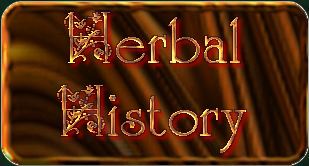

|
In an
archeological dig at a 60,000 year old Neanderthal burial ground, discoveries
were made that indicated these early people used marshmallow, yarrow and
groundsel, which are still in use today. An ancient
papyrus believed to have originated in the 16th century BCE before common era),
lists over 800 recipes which refer to 700 plus herbs used medicinally, including
wormwood, peppermint, myrrh, aloe, henbane and castor oil. The papyrus also
notes the used of moldy bread on sores and wounds to prevent infection. We
know from the cuneiform writings of the ancient Sumerians, that by 400 BCE,
opium, licorice, thyme and mustard were commonly used as medicinals. The
Babylonians used them also as well as senna leaves, saffron, coriander, cinnamon
and garlic. Prior
to 372 BCE, most herbal knowledge was passed verbally - much of these herbal
"secrets" were forgotten or misconstrued. Then Theophrastus (372-287
BCE) and Discorides (1st century CE) compiled detailed volumes identifying the
medicinal herbs and giving formulas and recipes which detailed the proper usages
(Inquiry Into Plants and Growth of Plants - Theophrastus, De Materia Medica -
Discorides). These volumes provided fundamental knowledge, much of which has
been proven quite valuable to this day. Another
major collection of herbal information was the 37 volume compilation Natural
History written by a Roman named Gaius Plinius Secundus or Pliny (the Elder) as
he is known today. Much of Plinyís information, however must be taken with a
grain of salt, for it relied heavily on legend, fabrications and superstitions.
It makes fascinating reading but itís not something one would want to base a
medicinal formula on. Another
common modern medicine was written about by poets of the Dark Ages during the
5th century. These sad poems chronicled the Willow Tree, which according to
legend, had bitter bark because the Christ child had once been beaten with one
of itís branches. Tea made from the bark eased many kinds of pain, colds,
fever, malaria and various other maladies. Today we know that the active
ingredient in Willow bark is Salacin, which we have synthesized into
acetylsalicylic acid - aspirin. 700
years ago Foxglove was prescribed by physicians to their patients who suffered
from chest pains and heart trouble. Now, we know that Foxglove contains
digitalis, which is still used to treat many heart patients. Christianity
had its own contributions to herbal history, even though the church itself made
a point of discrediting much of what non-Christians were teaching. One of which
was the hospital, first established in Byzantium by charitable Christians.
Another was the founding of the first of the university medical schools.
Students of this school actively experimented with the medicinal aspects of
various plants. In
the 12th century, the German Abbess, Hildegard von Bingen, wrote her Book of
Healing Herbs. As a Benedictine nun, Hildegard was taught the ancient
doctrine of humors; she also was very intuitive and had a broad knowledge of
folk cures gathered on her own. All this information was put together in her
book. The
ancient Aztec Emperors encouraged their people to learn about all varieties of
the regionís plants. When Cortez and the Conquistadors invaded Mexico in the
1500ís, they found the Aztecs quite learned in herbal knowledge and lore.
Fortunately, some of this knowledge survived the destruction of the Aztecís
civilization. King Phillip II of Spain, sent his personal physician to catalogue
and describe the Aztec plants. Francisco
Hernandez wrote down this information, which was to serve as the basic text on
the plants of Mexico for years to come. A
European doctor, visiting Peru in 1638, who observed a puma with a fever chewing
the bark that relieved itís fever, discovered quinine. This bark was
originally called "Peruvian Bark". 200 years later Pasteur found that
the bark contained quinine. Probably
the most famous herbal of all, was Nicholas Culpepperís The English Physician,
which was published in 1653. However,
it is debatable whether Culpepper really did any favors for herbal medicine.
Though much of his information was factual, his belief in Astrology was
considered a discrediting factor by some physicians.
Another
problem was his translation into everyday language the Latin Pharmacopeia, which
threatened the monopoly that the College of Physicians held, making medical
knowledge accessible to the masses. The physicians attempted to discredit
Culpepper by calling many of his herbal formulations and preparations quackery. In
the early years of this century, Seminole Indians used to grow Water Hyacinths
to clear fouled swamp water, we now know that Water Hyacinths destroy pollution
in water. Midwives of many Native American tribes used an herb called Calvacin
Puffball to prevent infection in freshly cut umbilical cords. Research at
Michigan State University has proven that an extract of the same herb has
stopped many forms of cancer in animals. The
Chinese used the stems of a low growing shrub to relieve asthma, colds,
congestion and coughs. The Chinese called this herb Mahuang.
We call it Ephedra, the source of Ephedrine, which is in many of our
over-the-counter decongestants. Native Americans had a vast storehouse of knowledge regarding medicinal plants. They instructed the early settlers in healing wounds, safe childbirth practices and setting fractures. The aspiring medicine-men of the Chippewas were extensively educated in the various plants, then they specialized in one disease or related group of diseases. We can thank our Native American brothers and sisters for the vast knowledge of many herbs that we use today, like cascara sagrada, American ginseng, joe-pye weed, goldenseal, sassafras and witch hazel.
|